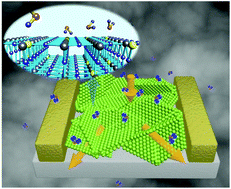Our official English website, www.x-mol.net, welcomes your
feedback! (Note: you will need to create a separate account there.)
High selectivity of sulfur-doped SnO2 in NO2 detection at lower operating temperatures†
Nanoscale ( IF 5.8 ) Pub Date : 2018-10-23 00:00:00 , DOI: 10.1039/c8nr05649h Keng Xu 1, 2, 3, 4, 5 , Shouqin Tian 6, 7, 8, 9 , Jia Zhu 5, 10, 11, 12 , Yong Yang 1, 2, 3, 4, 5 , Jing Shi 3, 4, 5, 11, 12 , Ting Yu 1, 2, 3, 4, 5 , Cailei Yuan 1, 2, 3, 4, 5
Nanoscale ( IF 5.8 ) Pub Date : 2018-10-23 00:00:00 , DOI: 10.1039/c8nr05649h Keng Xu 1, 2, 3, 4, 5 , Shouqin Tian 6, 7, 8, 9 , Jia Zhu 5, 10, 11, 12 , Yong Yang 1, 2, 3, 4, 5 , Jing Shi 3, 4, 5, 11, 12 , Ting Yu 1, 2, 3, 4, 5 , Cailei Yuan 1, 2, 3, 4, 5
Affiliation

|
Resistive gas sensors based on metal oxides have aroused great interest in the sensing of NO2 gas due to their low cost, good stability, and easy fabrication. However, drawbacks such as low sensitivity and a lack of selectivity, which originate from the limited kinds of intrinsic active centers on the surface of the metal oxides that could be involved in the gas-sensing reaction, remain great challenges to overcome. To solve these problems, surface modification of SnO2 by S-doping was carried out by the sintering of flower-like SnS2. Gas-sensing tests revealed that the S-doped SnO2 showed ultra-high sensitivity to NO2 (Rg/Ra = 600 toward 5 ppm) with low optimal operating temperature (50 °C). The detection limit of the sensor was as low as 50 ppb (Rg/Ra = 11). Notably, the S-doped SnO2 showed negligible cross-responses to alcohol, acetone, HCHO, SO2, H2S, and xylene. The ultra-high sensitivity and selectivity toward NO2 were closely related to the content of the S-dopant. This phenomenon is attributed to the active role of S-dopant during the surface reactions with NO2, which was substantiated by in situ Raman characterization and DFT-based calculations. This study offers an important guide for surface modification by doping to improve the sensitivity and selectivity of metal oxides and sheds new light on material design to develop resistive gas sensors for NO2 detection.
中文翻译:

在较低的工作温度下,NO 2检测中 对硫掺杂的SnO 2的高选择性†
基于金属氧化物的电阻式气体传感器价格低廉,稳定性好且易于制造,因此引起了人们对NO 2气体检测的极大兴趣。然而,诸如低灵敏度和缺乏选择性的缺点仍然是要克服的巨大挑战,这些缺点是金属氧化物表面上可能涉及气体感应反应的固有活性中心种类有限。为了解决这些问题,通过烧结花状SnS 2对SnO 2进行了S掺杂的表面改性。气敏测试表明,S掺杂的SnO 2对NO 2(R g / R a最佳工作温度(50°C)低时= 600朝向5 ppm)。传感器的检出限低至50 ppb(R g / R a = 11)。值得注意的是,S掺杂的SnO 2对醇,丙酮,HCHO,SO 2,H 2 S和二甲苯的交叉反应可忽略不计。对NO 2的超高灵敏度和选择性与S-掺杂剂的含量密切相关。这种现象归因于S-掺杂剂在与NO 2的表面反应中的积极作用,这在原位得到了证实。拉曼表征和基于DFT的计算。这项研究为通过掺杂改善金属氧化物的灵敏度和选择性提供了重要的表面改性指导,并为材料设计开发了用于检测NO 2的电阻性气体传感器提供了新的思路。
更新日期:2018-10-23
中文翻译:

在较低的工作温度下,NO 2检测中 对硫掺杂的SnO 2的高选择性†
基于金属氧化物的电阻式气体传感器价格低廉,稳定性好且易于制造,因此引起了人们对NO 2气体检测的极大兴趣。然而,诸如低灵敏度和缺乏选择性的缺点仍然是要克服的巨大挑战,这些缺点是金属氧化物表面上可能涉及气体感应反应的固有活性中心种类有限。为了解决这些问题,通过烧结花状SnS 2对SnO 2进行了S掺杂的表面改性。气敏测试表明,S掺杂的SnO 2对NO 2(R g / R a最佳工作温度(50°C)低时= 600朝向5 ppm)。传感器的检出限低至50 ppb(R g / R a = 11)。值得注意的是,S掺杂的SnO 2对醇,丙酮,HCHO,SO 2,H 2 S和二甲苯的交叉反应可忽略不计。对NO 2的超高灵敏度和选择性与S-掺杂剂的含量密切相关。这种现象归因于S-掺杂剂在与NO 2的表面反应中的积极作用,这在原位得到了证实。拉曼表征和基于DFT的计算。这项研究为通过掺杂改善金属氧化物的灵敏度和选择性提供了重要的表面改性指导,并为材料设计开发了用于检测NO 2的电阻性气体传感器提供了新的思路。











































 京公网安备 11010802027423号
京公网安备 11010802027423号